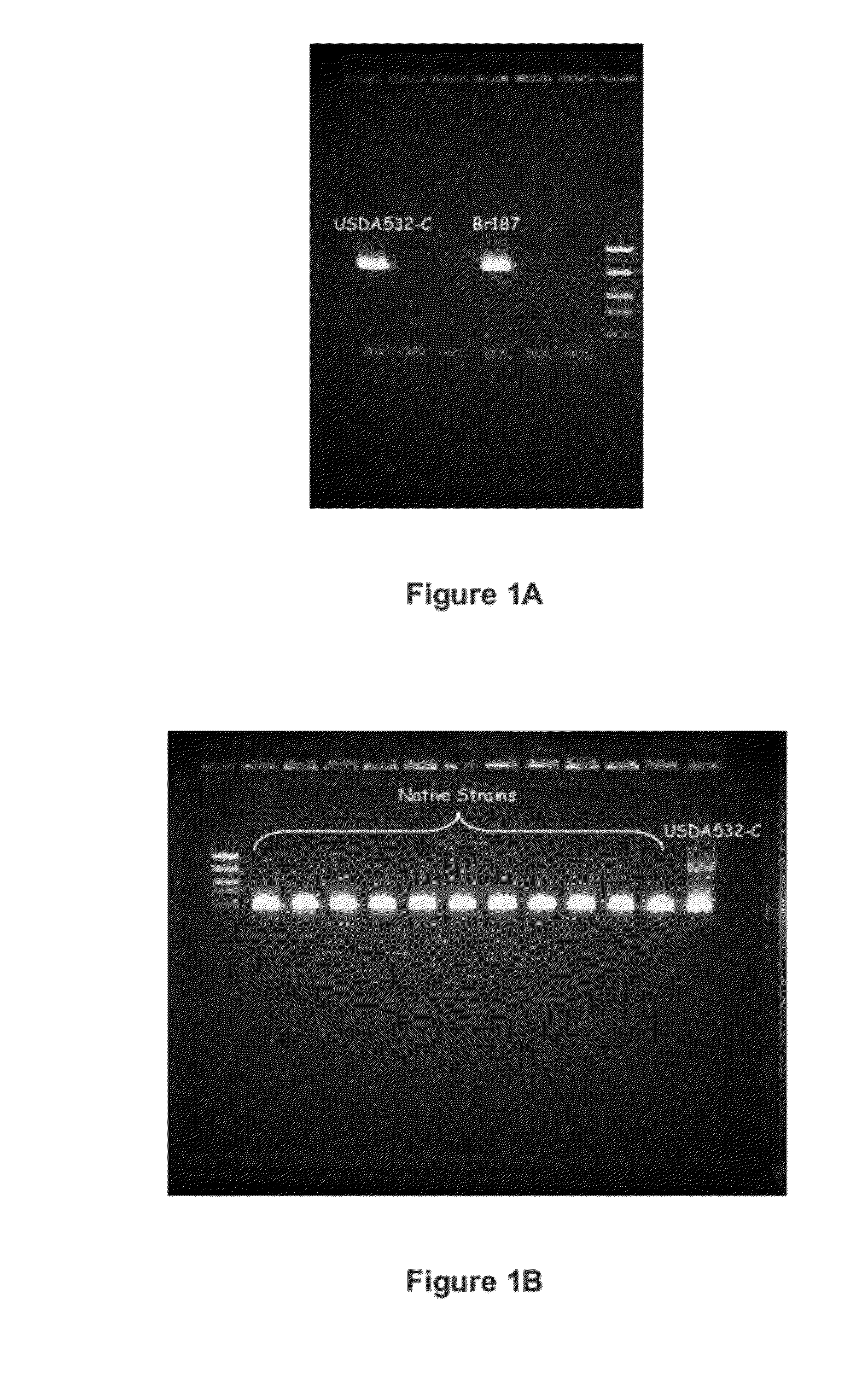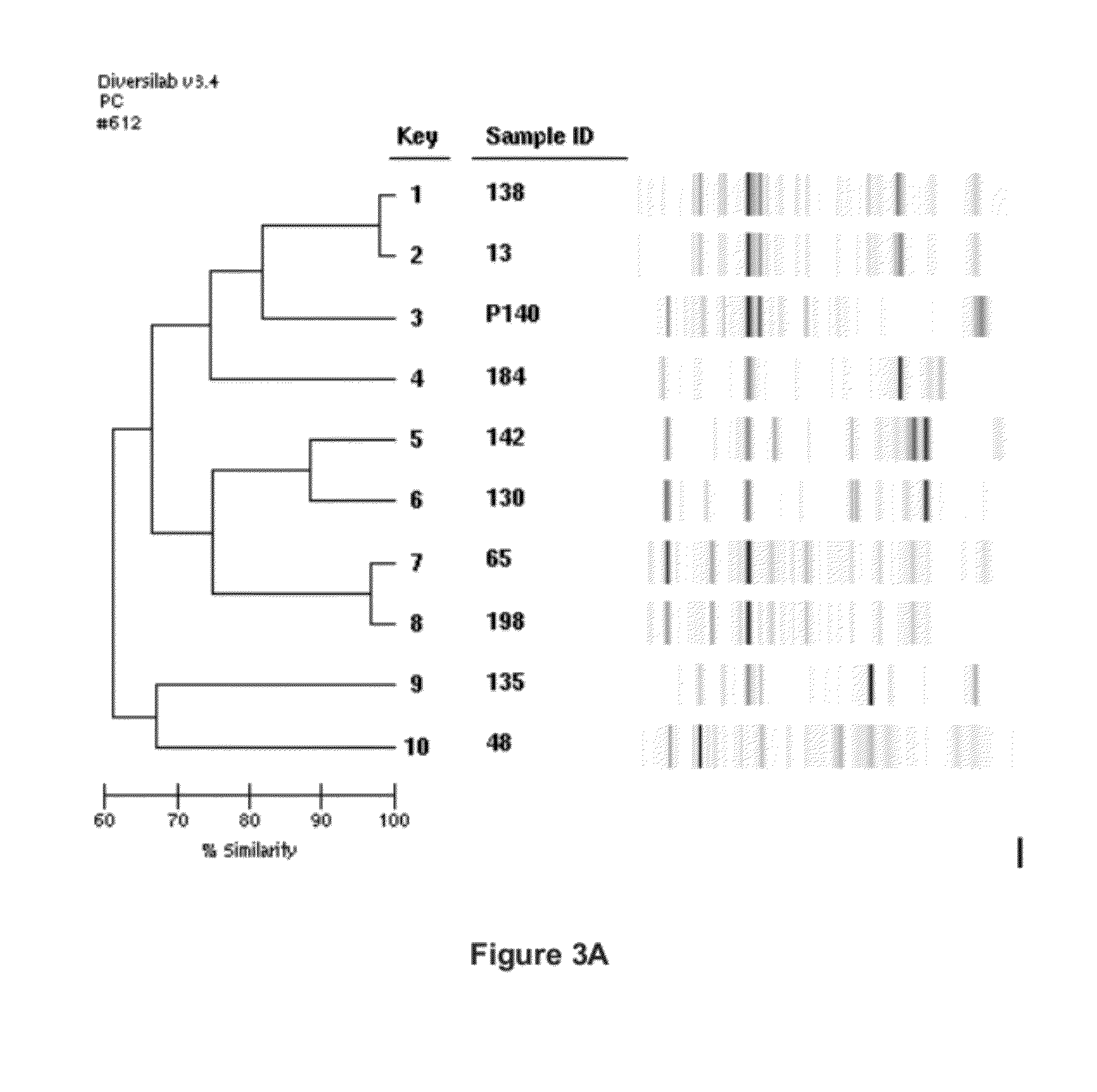Competitive and Effective Bacterial Strains
a technology of bacterial strains and bacterial strains, applied in the field of isolated bacterial strains, can solve the problems of impracticality of the method reported for screening large samples of microorganisms, and the inability to readily take up essential elements by plants, so as to improve the overall plant health and the availability of usable nitrogen sources for plants, and enhance overall plant growth
- Summary
- Abstract
- Description
- Claims
- Application Information
AI Technical Summary
Benefits of technology
Problems solved by technology
Method used
Image
Examples
example 1
[0186]Unique Primer Design for Commercial Bradyrhizobium strain USDA 532C
[0187]A genetic identification method was developed to evaluate the competitiveness of commercial Bradyrhizobium japonicum strain USDA 532C against native strains in the field. A primer specific to USDA 532C was identified and PCR technology was used to efficiently evaluate competitiveness of USDA 532C in the field.
[0188]Complete genome sequencing of USDA 532C was performed at Novozymes Davis. Twenty-five different DNA fragments were found to have low homology with public sequences of Bradyrhizobium japonicum. DNA was isolated from strains of B. japonicum (USDA 532C, P152, Br173, Br187, P190, and P194) grown on plates according to the procedure described supra (see Materials and Methods: DNA Isolation Protocol). Additional sequence analysis was performed on those twenty-five DNA fragments. Putative unique primers for USDA 532C strain were chosen and used for USDA 532C-specific primer screening by PCR against so...
example 2
Analyzing and Isolating Novel Strains
[0194]Primer 209 was used as a marker to indicate the presence or absence of colonization by Bradyrhizobia japonicum strain USDA 532C into the root nodules of soybean plants. Bands (i.e., a 0.9 kb band) indicating the presence of primer 209 represent a positive identification of Bradyrhizobia japonicum strain USDA 532C. See FIG. 2A. FIG. 2A is exemplary of an instance wherein Bradyrhizobia japonicum strain USDA 532C is the dominantly competitive strain for colonization of soybean plant nodules when compared to other native Rhizobial strains. In FIG. 2B, the number of bands indicating positive identification for primer 209, and therefore the presence of Bradyrhizobia japonicum strain USDA 532C, are reduced in comparison to the total number bands present for primer 209 in FIG. 2A. FIG. 2A and FIG. 2B demonstrate that the presence or absence of primer 209 can be used to determine whether USDA 532C is the dominantly competitive strain in the nodules ...
example 3
Head-to-Head Competition Evaluation
[0196]All isolated strains were put into a screening program designed to directly challenge the competitiveness of the isolate against Bradyrhizobium japonicum strain USDA 532C in terms of nodule colonization ability (see Materials and Methods: Competition Study Protocol).
[0197]Isolated primer 209 specific to USDA 532C was used as a marker to indicate the presence or absence of colonization by Bradyrhizobia japonicum strain USDA 532C into the root nodules of soybean plants. Positive identification for primer 209 indicated the colonization of Bradyrhizobia japonicum strain USDA 532C into the root nodules of soybean plants. Conversely, the absence of bands indicating positive identification for primer 209 indicated colonization of a native strain into the root nodules of soybean plants other than Bradyrhizobia japonicum strain USDA 532C. Isolated strains that exhibited a greater than 70% colonization of the analyzed nodules were chosen for a second e...
PUM
 Login to View More
Login to View More Abstract
Description
Claims
Application Information
 Login to View More
Login to View More - R&D
- Intellectual Property
- Life Sciences
- Materials
- Tech Scout
- Unparalleled Data Quality
- Higher Quality Content
- 60% Fewer Hallucinations
Browse by: Latest US Patents, China's latest patents, Technical Efficacy Thesaurus, Application Domain, Technology Topic, Popular Technical Reports.
© 2025 PatSnap. All rights reserved.Legal|Privacy policy|Modern Slavery Act Transparency Statement|Sitemap|About US| Contact US: help@patsnap.com



